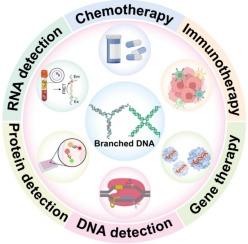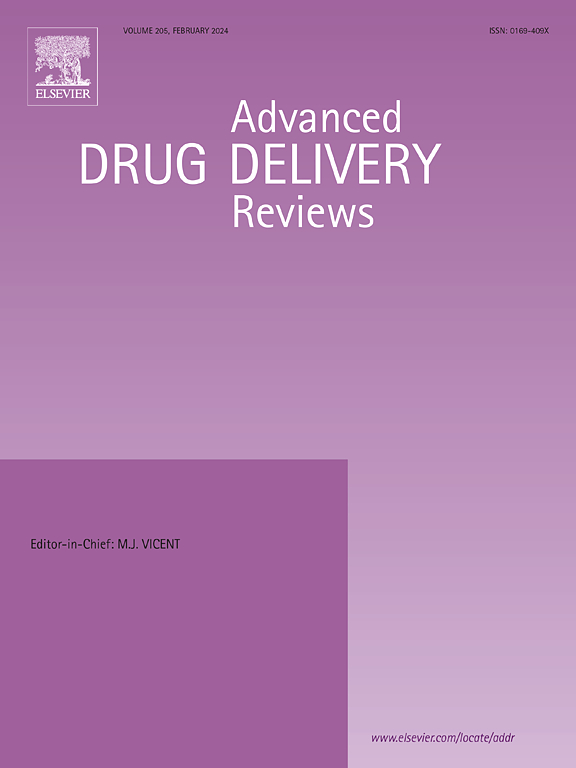分支DNA用于疾病诊断和治疗
IF 17.6
1区 医学
Q1 PHARMACOLOGY & PHARMACY
引用次数: 0
摘要
DNA表现出显著的多功能性,这归功于其固有的分子识别能力、可编程序列和出色的生物相容性。在其各种拓扑形式中,分支DNA (bDNA),包括y形DNA (Y-DNA), x形DNA (X-DNA)等,作为制造功能DNA基材料的基本构建块,近年来在各种应用中表现出巨大的前景。在疾病诊断和治疗迫切需求的推动下,bDNA已发展成为一个快速发展的领域。本文综述了合成bDNA单体及其组装成复杂功能材料的设计策略。介绍了bDNA在疾病诊断中的关键作用,强调了其在检测疾病相关生物标志物方面的应用,具有高灵敏度和特异性。此外,我们强调了基于bDNA的材料的治疗应用,如水凝胶和微球,特别是在癌症治疗和bDNA的临床转化方面。最后,讨论了bDNA技术在疾病诊断和治疗中面临的挑战和未来发展方向,为潜在的突破及其转化潜力提供了新的见解。这些进展突出了bDNA结构作为疾病诊断和治疗的强大工具的临床转化潜力,为改进疾病检测和个性化治疗提供了有希望的途径。本文章由计算机程序翻译,如有差异,请以英文原文为准。


Branched DNA for disease diagnosis and therapy
DNA exhibits remarkable versatility, which is attributed to its inherent molecular recognition capabilities, programmable sequences, and excellent biocompatibility. Among its various topological forms, branched DNA (bDNA), including Y-shaped DNA (Y-DNA), X-shaped DNA (X-DNA), etc., stands out as a fundamental building block for fabricating functional DNA-based materials and has demonstrated great promise across diverse applications in recent years. Motivated by urgent demands in disease diagnosis and therapy, bDNA has developed into a rapidly advancing field. In this review, the design strategies for synthesizing monomers of bDNA and their assembly into complex functional materials are summarized. The pivotal role of bDNA in disease diagnostics is presented, emphasizing its utility in detecting disease-related biomarkers with high sensitivity and specificity. Additionally, we highlight the therapeutic applications of bDNA-based materials, such as hydrogels and microspheres, particularly in cancer treatment and the clinical translation of bDNA. Finally, the challenges and future directions for advancing bDNA technology in disease diagnosis and therapy are discussed, providing new insights into potential breakthroughs and their translational potential. These advances highlight the clinical translational potential of bDNA structures as powerful tools for disease diagnosis and treatment, offering promising avenues for improved disease detection and personalized therapy.
求助全文
通过发布文献求助,成功后即可免费获取论文全文。
去求助
来源期刊
CiteScore
28.10
自引率
5.00%
发文量
294
审稿时长
15.1 weeks
期刊介绍:
The aim of the Journal is to provide a forum for the critical analysis of advanced drug and gene delivery systems and their applications in human and veterinary medicine. The Journal has a broad scope, covering the key issues for effective drug and gene delivery, from administration to site-specific delivery.
In general, the Journal publishes review articles in a Theme Issue format. Each Theme Issue provides a comprehensive and critical examination of current and emerging research on the design and development of advanced drug and gene delivery systems and their application to experimental and clinical therapeutics. The goal is to illustrate the pivotal role of a multidisciplinary approach to modern drug delivery, encompassing the application of sound biological and physicochemical principles to the engineering of drug delivery systems to meet the therapeutic need at hand. Importantly the Editorial Team of ADDR asks that the authors effectively window the extensive volume of literature, pick the important contributions and explain their importance, produce a forward looking identification of the challenges facing the field and produce a Conclusions section with expert recommendations to address the issues.

 求助内容:
求助内容: 应助结果提醒方式:
应助结果提醒方式:


